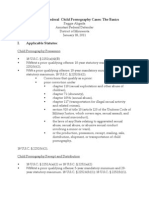Moveo Case Study Guillan Barre
Moveo Case Study Guillan Barre
Uploaded by
Priyanka MathurCopyright:
Available Formats
Moveo Case Study Guillan Barre
Moveo Case Study Guillan Barre
Uploaded by
Priyanka MathurCopyright
Available Formats
Share this document
Did you find this document useful?
Is this content inappropriate?
Copyright:
Available Formats
Moveo Case Study Guillan Barre
Moveo Case Study Guillan Barre
Uploaded by
Priyanka MathurCopyright:
Available Formats
Darin Trees, PT, DPT, CWS Moveo XP Beta Test Series
Case Study Guillain-Barr Syndrome
History
57 year-old male admitted to the emergency room with difficulty walking and numbness to the feet, diagnosed with Guillain-Barr Syndrome. The patient was moved to the ICU and placed on mechanical ventilation due to respiratory failure. He underwent five treatments of plasmaphoresis and required a tracheostomy for long-term mechanical ventilation. Physical therapy was consulted to begin rehabilitation. Patient was independent with all ADLs prior to admission.
PT Evaluation
General: Patient was mentally alert and could follow simple commands. Due to severe facial weakness, patient communicated by blinking for yes/no. Respiratory: Patient on ventilator in Assist Control mode. Strength: Bilateral UEs grossly 2/5. Hip and knee musculature grossly 2/5, ankle strength 0/5. Bed mobility, transfers: Dependent for rolling and supine-to-sit. Transfers not tested due to severe weakness. Sitting balance: Poor static and dynamic. Dependent to sit upright at edge of bed.
Treatment
Patient education included an in-bed exercise program, breathing exercises, progressive sitting, trunk control activities, and daily use of a dynamic tilt exercise platform to develop lower extremity partial weight-bearing (PWB) strength training. For the PWB workout, the patient performed three to four sets of 10 inclined squats with tolerable resistance. The first session started with approximately 15% body weight with the patient progressing to 55% body weight after two weeks. During this time, sitting balance improved from dependent to unsupported sitting at bedside. Sit-to-stand assessment showed that the patient was unable to support full body weight and required maximal assistance to stand. For this reason, PWB exercise on the platform was continued for lower extremity strengthening. The therapy treatments then alternated manual standing on one day with PWB exercise the following day. This regimen continued for one week, at which time the patient could stand with minimal assistance using a rolling walker for support. The exercise platform was then discontinued so the patient could focus on progressive standing and gait training with a walker for the next two weeks.
Discharge
The patient was discharged to home, walking with a rolling walker 300, independent with transfers and bed mobility. The patient required supervision for ascending and descending stairs. The patient followed up with outpatient PT to restore endurance and balance.
Patient dependent to sit upright.
Patient performs inclined squats independently at 25% body weight.
Patient progressed to inclined squats with 65% body weight. Weaned to trach collar during days. Patient able to stand with a rolling walker and minimal assistance. Exercise platform discontinued to focus on progressive standing and gait training.
Patient able to sit unsupported.
Patient requiring maximal assistance to stand upright. Dynamic tilt exercise platform continued.
Patient discharged at modified independent level for ambulation with a rolling walker 300. Patient can ascend/descend stairs with supervision.
2009 Encore Medical, L.P., and Affiliates 7011B 0209
seemoveo.com
You might also like
- PHOTOSHOP FOR ARCHITECTURE.Document10 pagesPHOTOSHOP FOR ARCHITECTURE.Kanak YadavNo ratings yet
- NCP For Impaired MobilityDocument4 pagesNCP For Impaired MobilityBettinaFernandoNo ratings yet
- Case ReportDocument9 pagesCase Reportapi-216088427No ratings yet
- Case Study Stroke RehabilitationDocument1 pageCase Study Stroke RehabilitationJanantik PandyaNo ratings yet
- Transferring The PatientDocument1 pageTransferring The Patientrrchipolito.studentNo ratings yet
- Soap ExampleDocument2 pagesSoap Exampleapi-486552951No ratings yet
- Patient Case Study Total Joint ReplacementDocument8 pagesPatient Case Study Total Joint Replacementapi-550620891No ratings yet
- Case StudyDocument3 pagesCase StudySarah Padgett100% (1)
- Functional Re EducationDocument38 pagesFunctional Re EducationDhruvNo ratings yet
- C:/Documents and Settings/student/Desktop/physiotherapy Protocol FOR HEMIPLEGIC PDFDocument13 pagesC:/Documents and Settings/student/Desktop/physiotherapy Protocol FOR HEMIPLEGIC PDFSenthilkumar ThiyagarajanNo ratings yet
- Mobilization Protocols (As Being Performed in HospitalsDocument14 pagesMobilization Protocols (As Being Performed in HospitalsMuhammad asif samiNo ratings yet
- Revised Ebersole Orif PosterDocument1 pageRevised Ebersole Orif Posterapi-290917332No ratings yet
- Assessment Data Nursing Diagnosis Planning Intervention Rationale EvaluationDocument2 pagesAssessment Data Nursing Diagnosis Planning Intervention Rationale EvaluationCrystelle MonaresNo ratings yet
- Physical Therapy Protocol For Acute Care Adult HemiplegiaDocument12 pagesPhysical Therapy Protocol For Acute Care Adult Hemiplegiaj_______________jNo ratings yet
- Case ReportDocument14 pagesCase Reportapi-678217089No ratings yet
- Case ReportDocument10 pagesCase Reportapi-678326591No ratings yet
- Questions For The StudentDocument5 pagesQuestions For The StudentChaman Lal KarotiaNo ratings yet
- Case StudyDocument3 pagesCase Studyapi-548963107No ratings yet
- BMAT-Bedside Mobility Assessment Tool: by Amber Perez ADN, BSB, CSPHPDocument36 pagesBMAT-Bedside Mobility Assessment Tool: by Amber Perez ADN, BSB, CSPHPConvalescent Nursing HomeNo ratings yet
- Move To Improve Progressive Mobility in ICUDocument3 pagesMove To Improve Progressive Mobility in ICUafdaldoank22No ratings yet
- JIMENEZ, Kaycelyn A. - FDARDocument2 pagesJIMENEZ, Kaycelyn A. - FDARkaycelyn jimenezNo ratings yet
- Amputation Below KneeDocument1 pageAmputation Below KneeLisnainiMuchlisNo ratings yet
- Therapeutic Skill Scenarios For Practical ExaminationDocument7 pagesTherapeutic Skill Scenarios For Practical ExaminationrobpenmanNo ratings yet
- Case 3 - JJ - Oral PracticalDocument3 pagesCase 3 - JJ - Oral PracticalCindy MurphyNo ratings yet
- Mobility 1Document47 pagesMobility 1Jan LagriaNo ratings yet
- BPPVDocument26 pagesBPPVshobhna mishraNo ratings yet
- FON (Positioning)Document3 pagesFON (Positioning)Richie NadzNo ratings yet
- Health Teaching PlanDocument5 pagesHealth Teaching PlanLester Dalanon100% (1)
- Checklist On Assisting A Patient To AmbulateDocument2 pagesChecklist On Assisting A Patient To AmbulateJay Ann BernalesNo ratings yet
- HEalth Education Plan CVADocument4 pagesHEalth Education Plan CVAJoenaCoy ChristineNo ratings yet
- Musculo Skeletal AssessmentDocument4 pagesMusculo Skeletal Assessmentsriram gopalNo ratings yet
- PT To Prevent Pressure SoresDocument25 pagesPT To Prevent Pressure SoresSelvi SoundararajanNo ratings yet
- Checklists For Transfer and AmbulationDocument15 pagesChecklists For Transfer and Ambulationmido100% (1)
- Bahasa Inggris Kel 5Document4 pagesBahasa Inggris Kel 5Laili Muthia GhinaNo ratings yet
- NCP Sample OrthoDocument5 pagesNCP Sample OrthoKatzii FranciaNo ratings yet
- Ci Copy SoapDocument3 pagesCi Copy SoapfridayisanewdayNo ratings yet
- Au NCPDocument1 pageAu NCPCarlo Medina MagnoNo ratings yet
- DP Discharge Plan@@@@@@@@Document6 pagesDP Discharge Plan@@@@@@@@Maemae SumalinogNo ratings yet
- Above Knee Amputee Amputee Case StudyDocument4 pagesAbove Knee Amputee Amputee Case StudyPhysiotherapist AliNo ratings yet
- E Notes Assissting With Ambulation of PatientDocument3 pagesE Notes Assissting With Ambulation of PatientAnonymous hYMWbANo ratings yet
- Ob and Gyne PDF 3Document5 pagesOb and Gyne PDF 3M.A. Ch.No ratings yet
- Walking and Advanced RehabilitationDocument49 pagesWalking and Advanced Rehabilitationtradeforex8585No ratings yet
- Position S: Pratiksha RaiDocument49 pagesPosition S: Pratiksha RaiJoanne Cristie TolopiaNo ratings yet
- Stroke Rehab Lower LimbDocument28 pagesStroke Rehab Lower Limbinfo.etc.pkNo ratings yet
- Marias Rehab Program Rehab Program For RehabDocument15 pagesMarias Rehab Program Rehab Program For Rehabapi-547830791No ratings yet
- Nursing Care Plan Cues Nursing Diagnosis Analysis Goal and Objectives Nursing Interventions Rationale EvaluationDocument3 pagesNursing Care Plan Cues Nursing Diagnosis Analysis Goal and Objectives Nursing Interventions Rationale EvaluationEvan SmixNo ratings yet
- Nursing Care Plans: Desired Outcome Interventions Impaired Physical MobilityDocument6 pagesNursing Care Plans: Desired Outcome Interventions Impaired Physical MobilityNaomi MasudaNo ratings yet
- Bechtel Final ApprovedDocument31 pagesBechtel Final Approvedapi-468018392No ratings yet
- Case Study Module 3Document4 pagesCase Study Module 3RiccardoNo ratings yet
- Flores - BSPT 1a - Activity 15 - Weighted Jumping RopeDocument6 pagesFlores - BSPT 1a - Activity 15 - Weighted Jumping RopeBrandon FloresNo ratings yet
- Case ReportDocument13 pagesCase Reportapi-676777659No ratings yet
- Hip 3Document14 pagesHip 3nagyrashad123No ratings yet
- ACL Reconstruction: Patellar Tendon Graft/Hamstring Tendon GraftDocument6 pagesACL Reconstruction: Patellar Tendon Graft/Hamstring Tendon GraftArun TamilvananNo ratings yet
- 3439450Document31 pages3439450Ameng GosimNo ratings yet
- Acl Reconstruction ProtocolDocument8 pagesAcl Reconstruction ProtocolMestereaga AlinNo ratings yet
- Bed Positioning With DiagnosisDocument149 pagesBed Positioning With DiagnosisGrace Marquez BilogNo ratings yet
- Body MechPos Mob Dev.Document3 pagesBody MechPos Mob Dev.Alyssa Jade GolezNo ratings yet
- Multiple Choice RatioDocument14 pagesMultiple Choice RatioDivine Joe Grace Marcelino100% (2)
- NCLEX-RN Physiological Integrity Exam Prep :300 Practice Questions with Detailed Answers and Explanation to Master Your Exam: NCLEX-RN EXAM PREP:PRACTICE QUESTIONS AND ANSWERS, #4From EverandNCLEX-RN Physiological Integrity Exam Prep :300 Practice Questions with Detailed Answers and Explanation to Master Your Exam: NCLEX-RN EXAM PREP:PRACTICE QUESTIONS AND ANSWERS, #4No ratings yet
- Nursing Study Guide: Your Nursing Assistant To Do Well In SchoolFrom EverandNursing Study Guide: Your Nursing Assistant To Do Well In SchoolRating: 3 out of 5 stars3/5 (2)
- 5 PMP Prepare - PMBOK Edition Professional Responsibility: Difficulty Memorization Exam ImportanceDocument70 pages5 PMP Prepare - PMBOK Edition Professional Responsibility: Difficulty Memorization Exam ImportanceAllwyn GeorgeNo ratings yet
- Lic & GicDocument6 pagesLic & GicPrachi RajanNo ratings yet
- Project Report IBDocument17 pagesProject Report IBrosine NdikubwimanaNo ratings yet
- Night Shift FormDocument2 pagesNight Shift FormAnonymous kWfNFbNo ratings yet
- Limitless Learning AssessingDocument23 pagesLimitless Learning AssessingSushan MaharjanNo ratings yet
- Lec 6 A Capacity PlanningDocument20 pagesLec 6 A Capacity PlanningPriyanka KelgandreNo ratings yet
- Electrode Consumption PDFDocument1 pageElectrode Consumption PDFharold_bhieNo ratings yet
- 08 Procedure For Design and Development Preview enDocument4 pages08 Procedure For Design and Development Preview enHadj Ali BoumedieneNo ratings yet
- NIBA Belt Line December 2015Document17 pagesNIBA Belt Line December 2015NIBA- The Belting AssociationNo ratings yet
- Kosmos 54 - 052012Document2 pagesKosmos 54 - 052012suyeruiNo ratings yet
- AC Substation Detailed Design Guidelines Best Practice Dos and DontsDocument29 pagesAC Substation Detailed Design Guidelines Best Practice Dos and Dontsahmad shakeebNo ratings yet
- Materi M6 Planning-Schedulling - Optimization (FINAL)Document82 pagesMateri M6 Planning-Schedulling - Optimization (FINAL)Panjul IdNo ratings yet
- That Palastic Bag Should Be BannedDocument12 pagesThat Palastic Bag Should Be Bannedlili afidaNo ratings yet
- Aditya Divya Lounge Power LayoutDocument1 pageAditya Divya Lounge Power LayoutSonali KaurNo ratings yet
- Direct Instruction Lesson Template 2017 1 - 2Document2 pagesDirect Instruction Lesson Template 2017 1 - 2api-455662270No ratings yet
- Defending Child Porn CasesDocument6 pagesDefending Child Porn CasesBrian MartinNo ratings yet
- PATHOPHYSIOLOGY ECTOPIC PREGNANCY SoftDocument11 pagesPATHOPHYSIOLOGY ECTOPIC PREGNANCY SoftJann ericka JaoNo ratings yet
- Sika 1 PDS PDFDocument2 pagesSika 1 PDS PDFcassandratruzNo ratings yet
- 16-1102 Views of The United StatesDocument32 pages16-1102 Views of The United StatesFlorian MuellerNo ratings yet
- Sway With MeDocument10 pagesSway With MeRuth Soto GarciaNo ratings yet
- Power Flow Literature ReviewDocument6 pagesPower Flow Literature Reviewfve140vb100% (1)
- Pro Resume With Blog and Headshot PDFDocument1 pagePro Resume With Blog and Headshot PDFBella BrewerNo ratings yet
- Ce Orientation Part 3 PDFDocument15 pagesCe Orientation Part 3 PDFFrancis Ko Badongen-Cawi Tabaniag Jr.0% (2)
- Maternal and Child Nursing - Antepartum Practice Test With AnswersDocument6 pagesMaternal and Child Nursing - Antepartum Practice Test With Answersgelean payodNo ratings yet
- MS-BDP-006-Concrete Pavement Demolition and Excavation WorkDocument15 pagesMS-BDP-006-Concrete Pavement Demolition and Excavation WorkMohmed NishadNo ratings yet
- MEMMERT BR Heating Ovens English D13646Document32 pagesMEMMERT BR Heating Ovens English D13646Anonymous Z6BF3n78No ratings yet
- Toffee Packing MachinesDocument10 pagesToffee Packing MachinesZakria MakhdumNo ratings yet
- Machine Learning and Artificial Intelligence: PG Diploma inDocument23 pagesMachine Learning and Artificial Intelligence: PG Diploma inAgent ShawNo ratings yet
- UntitledDocument2 pagesUntitledSnezhana MalyarovaNo ratings yet

























































































